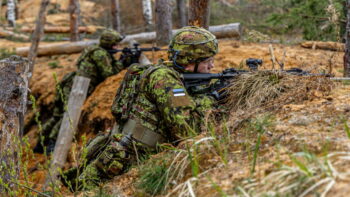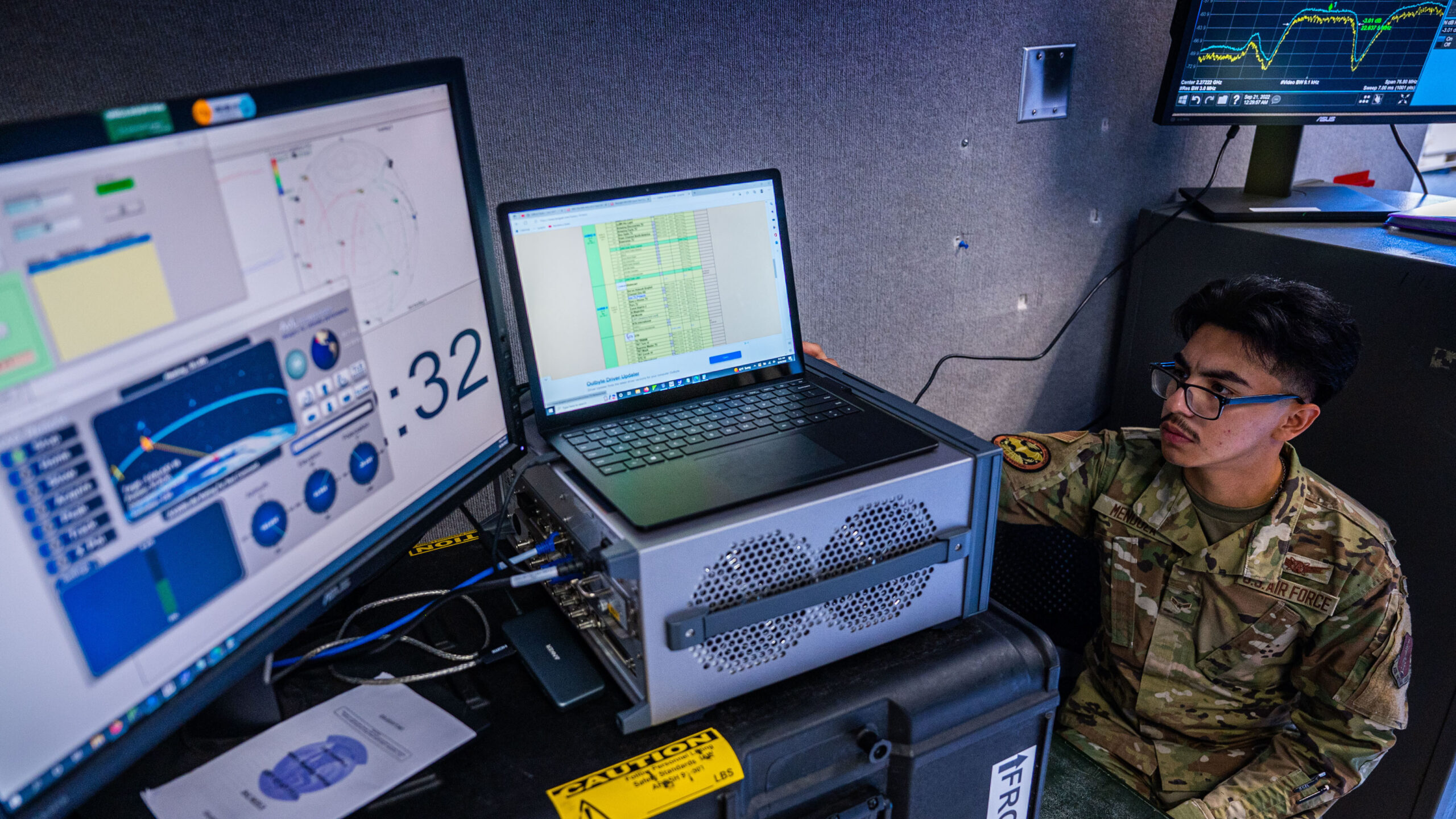
Air Force Airman 1st Class Mendoza utilizes a ‘Honey Badger System’ during Space Training and Readiness Command’s Black Skies 22 at Vandenberg Space Force Base, Calif., Sept. 20, 2022. (US Space Force photo by Tech. Sgt. Luke Kitterman)
WASHINGTON — The Space Force’s new “operations” doctrine for the first time lays out how the newest military service sees its roles within the Joint Force during peace and war — not just to protect and defend US space assets, but also to defend terrestrial forces and enhance their “lethality” by using “combat power” in any fight.
The document represents a first foundational action plan for the Space Force, and more clearly defines how it bounds its own specific missions, such as “offensive” and “defensive” space operations, and the relatively new concept of “mobility and logistics” in space.
“Seizing space superiority at the time and place of our choosing can offer advantages to military forces. … Space Doctrine Publication (SDP) 3-0, Operations, as keystone doctrine for the United States Space Force (USSF) describes official advice and best practices for supporting the joint force commander (JFC) in gaining and exploiting this position of advantage within the space domain,” Maj. Gen. Shawn Bratton, head of Space Training and Readiness Command (STARCOM), writes in the document’s [PDF] preface.
The role of doctrine is to set the foundational principles to guide military forces as they pursue national security objectives, as well as to establish agreed concepts and terms to prescribe the manner in which they will fight. There are various levels of doctrine, with that crafted by the Joint Staff to guide joint force operations at the top of the food chain. Each military service then writes its own hierarchy of doctrinal papers covering specific roles and missions.
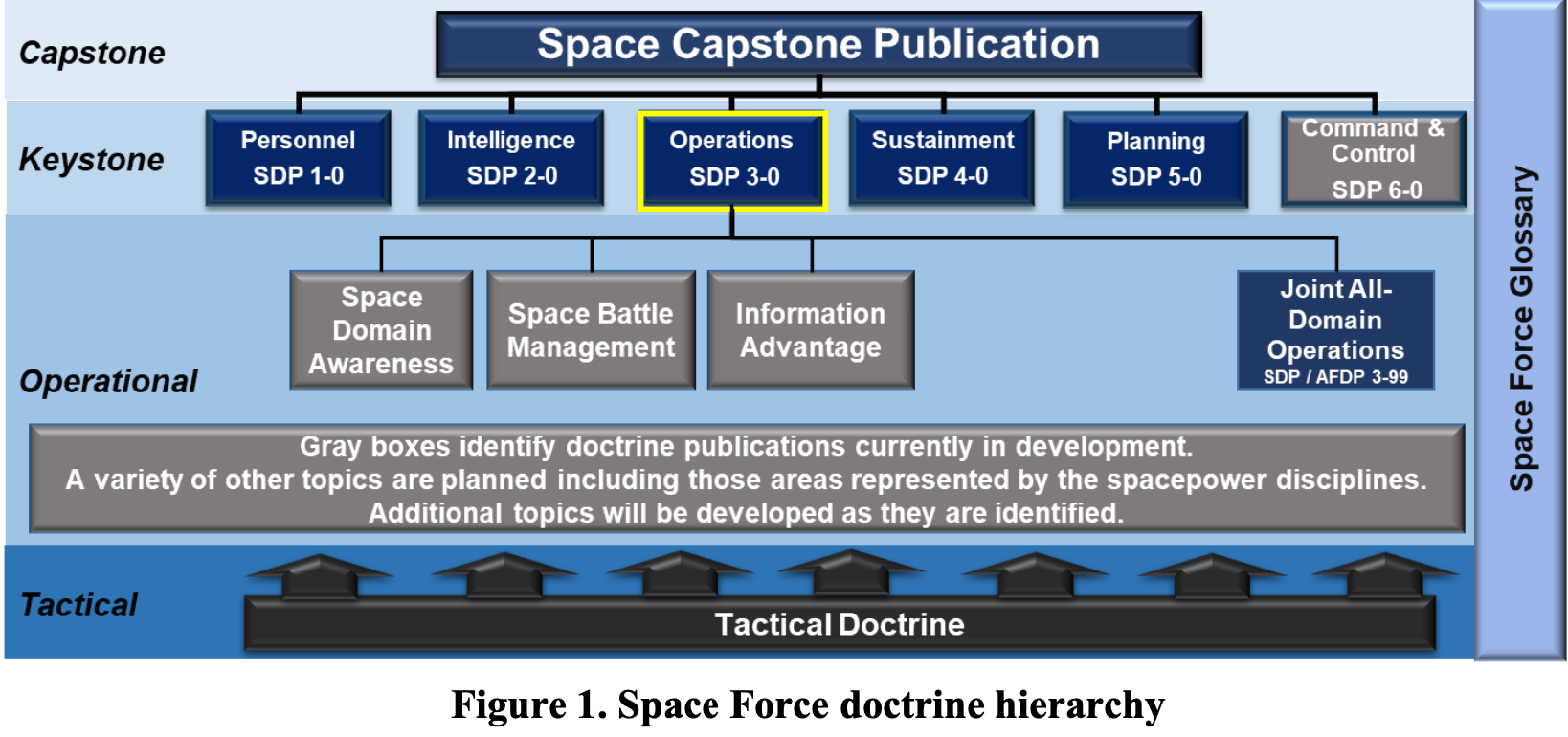
SDP 3.0 Space Doctrine hierarchy (screengrab)
The Space Force, as the newest military service, and US Space Command since their creation in 2019 have been attempting to revamp US military space doctrine in a domain that over the past decade has become both more complex and more fraught with risk. (As a reminder, the Space Force organizes, trains and equips Guardians to operate space systems; SPACECOM runs actual military space operations.)
The Space Force’s first formal doctrinal paper was the Space Capstone Publication: Spacepower, published in 2020 that sought to define space as a separate warfighting domain, and “spacepower” as vital to future joint operations. Building on that, STARCOM last year published a series of subordinate doctrine papers on personnel, sustainment and planning.
STARCOM published both SDP 3.0 on July 31, along with a new “Intelligence” doctrine, SDP-2.0, that “outlines how intelligence contributes to space operations, enhances the body of intelligence data available to joint warfighters, and underscores the role of Guardians in the intelligence community,” according to a STARCOM fact sheet.
Supporting the Joint Force Across the Conflict Spectrum
SDP 3.0, however, arguably is one of the most important of the publications so far, in that represents the roadmap for how Guardians will employ spacepower to support SPACECOM and the joint force across the spectrum of conflict — from what the Pentagon now sees as the ubiquitous “competition” phase (essentially a modern equivalent of the Cold War only with multiple adversaries) all the way through a hot war.
To that end, the new doctrine paper says, the Space Force will undertake operations in three baskets:
- Shape the Operational Environment. Space operations include activities to promote security and stability, preserve freedom of action, and deter adversary activities to the contrary. … Guardians communicate with other DoD and Intelligence Community organizations, while building relationships with allies, partners, commercial entities, and academia. Along with data sharing and collaboration, where appropriate and authorized, these relationships help build support for operations in all domains, increase overall security in the space domain, promote appropriate behavior in space, and deter adversaries.
- Prevent Conflict. Space operations to prevent conflict in, from, and to space include all activities to deter undesirable actions by an adversary. … Space operations enhance safety and security of joint operations and deterrence in all domains. … As part of the joint force, Guardians focus on actions to deter dangerous or unlawful adversary behavior in all domains through a range of reversible and non-reversible effects.
- Prevail In Combat. Should deterrence fail, the Space Force is prepared to enable lethality and effectiveness of the JFC by delivering space combat power to ensure the United States prevails in conflict. Guardians as part of the joint force will take actions to deter undesirable adversary behavior and deny, disrupt, damage, or destroy adversary space capabilities in all domains. Planners may also consider deceptive operations with appropriate authorities.
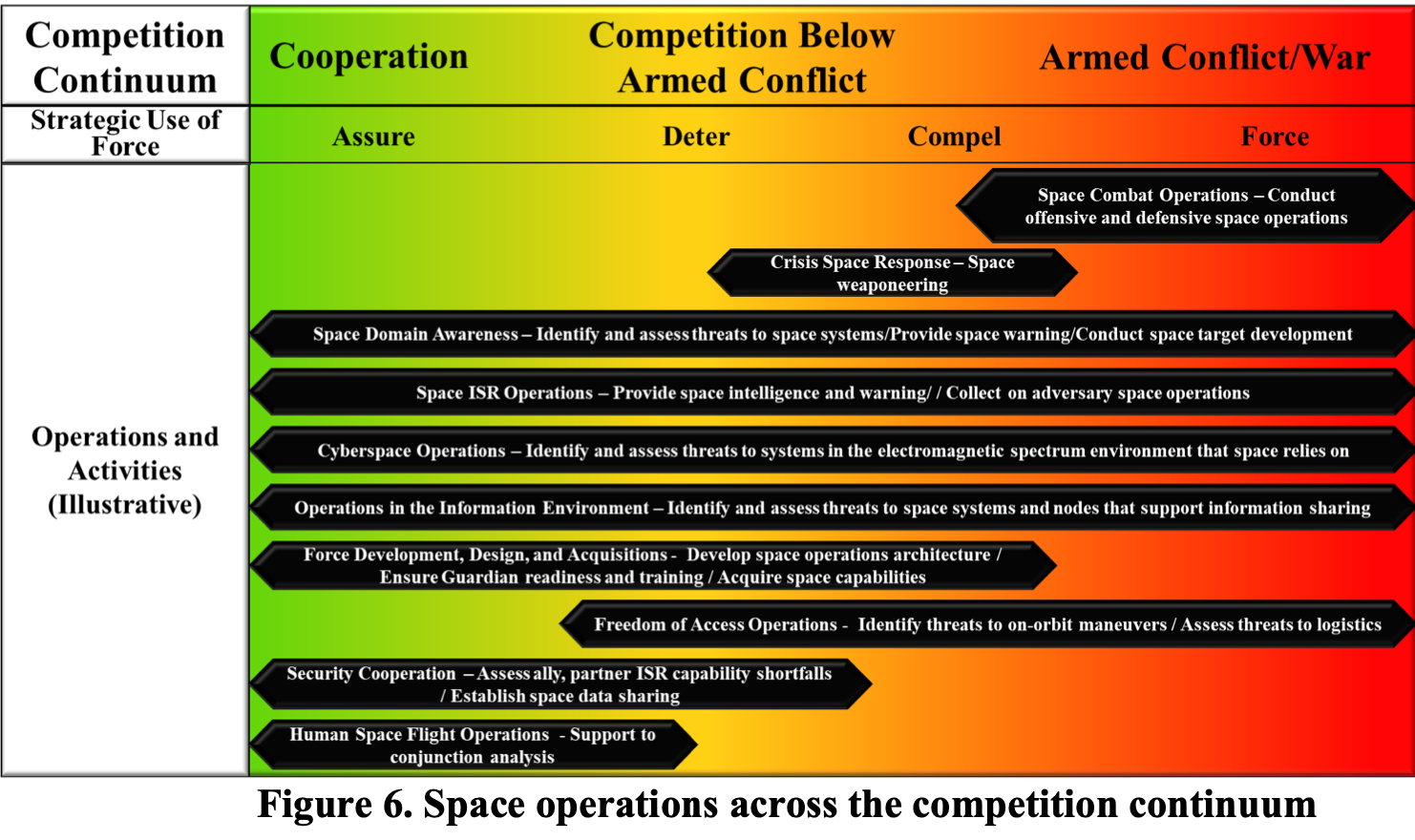
SDP 3.0 conflict spectrum for space ops. (screengrab)
SDP 3.0 builds on the unofficial “Space Doctrine Note, Operations” [PDF] published by Space Force headquarters in January. While it also builds on “Joint Publication 3-14 Space Operations (JP 3-14)”, last updated by the Joint Staff in 2020, it also deviates somewhat from it. For example, the Space Force has subtly changed the definition of “space superiority” from that in JP 3-14 to include not just ensuring US space systems are protected from interference, but also “denying” opponents “freedom of action” in space.
Interestingly, rather than seeking to align directly with joint space operations doctrine, the new Space Force doctrine is focused more closely on mapping space activities to the 12 principles of military operations writ large, as detailed in the Joint Staff’s top-level doctrine publication, “JP 3.0 Joint Campaigns and Operations”, last updated on June 18, 2022.
“I thought the discussion of how they’re translating the principles of joint operations (objective, offense, mass, maneuver, etc.) to space was interesting. None of it was entirely surprising, but it was useful to see space operations being described using the same language that the US military uses to describe military operations in all the other domains and some of the distinct space differences,” Secure World Foundation’s Brian Weeden said.
For example, he said, the doctrine’s interpretation of “mass” for the Space Force “focuses more on managing space applications and services rather than just the number of satellites themselves, because many of the satellites are still moving around in orbit and often support more than one theater at a time,” he told Breaking Defense.
SDP 3.0 also specifically includes a section on how space operations fit into “Joint All Domain Operations”, as articulated by the Department of the Air Force in “Space Doctrine Publication/Air Force Doctrine Publication 3-99″, published in November 2021. Noting the centrality of “mutual support” across domains, SDP 3.0 also recognizes that “the most effective operation to deny, disrupt, damage, or destroy an adversary’s space capability, and preserve freedom of action in space, may originate from a domain other than space.”
Defining Terms Of Art: Offensive Vs. Defensive; Mobility
The new Space Operations doctrine further is notable for the fact that it articulates the 13 mission areas the Space Force sees as its own. These range from traditional ones such as space domain awareness and positioning, navigation and timing to what might be seen as newer, or at least more expansively defined, missions such as “combat power projection” and “space mobility and logistics.”
In particular, the section on “combat power projection” provides an official service view of offensive versus defensive operations in support of joint operations — something Space Force and Pentagon leaders are often hesitant to do in public:
The projection of combat power, as space combat power, includes offensive and defensive military force (fires and protection) in, from, or to the space domain (including navigation warfare). Offensive space operations attack the adversary in, from, or to space. These operations seek to impose cost on the adversary, compel a change in behavior, secure a position of advantage, or deny the adversary’s military forces freedom of action. Defensive space operations seek to repel or defeat adversary attacks in, from, or to the space domain. These operations aim to maintain status quo, regain the initiative, deny the adversary a position of advantage, or protect freedom of action of friendly forces. The distinction between offensive and defensive operations is not always clear. …
In planning, Guardians consider offensive and defensive fires in terms of which side is attempting to retain or exploit the initiative (offense) and which side is responding to the adversary’s initiative (defense). All combat operations should include elements of offense and defense unified into coherent action to achieve desired effects.
The document also provides a first official definition of “space mobility and logistics” — a Space Force-specific take on what is known as “maneuver” in joint operations.
“Space mobility and logistics, also referred to as SAML, supports joint space operations sustainment through spacelift, satellite operations, force reconstitution, maintenance of a force of space operations personnel, and support to human space flight,” SDP 3.0 explains. “Mobility (movement and maneuver) includes post-launch transport of space vehicles between orbits, within orbits, and augmented maneuvering to enhance mission effectiveness or maneuvering related to reconstitution, operational degradation or loss, and end-of-life actions. In the future, logistics on-orbit may include spacecraft servicing, disposition, debris management capabilities, refueling, and in-space component installation.”
Looking To The Future
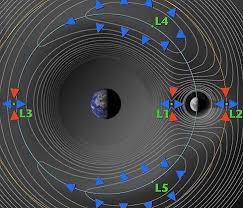
Earth-Moon Lagrange points (NASA image)
Finally, SDP 3.0 gives a nod to the fact that Space Force missions may expand in the future to deep space; that is, outside the confines of the Earth’s gravitational field.
“The Space Force currently defines three nested orbital regimes for space operations,” the document says.
Today’s military space operations take place largely in what SDP 3.0 calls “geocentric regime” — essentially, low Earth orbit, medium Earth orbit, and geosynchronous orbit.
The other two regimes are: the “cislunar regime” that includes the “translunar space” between the Earth and the Moon, the relatively stable Earth-Moon Lagrange points, and orbits around the Moon; and the “solar regime” comprising orbits around the Sun, and “the Lagrange points characterized by the combined gravitational effects of the Sun and the planets.”
However, the Space Force apparently is looking even farther out into the heavens. “Future military space operations may extend beyond these three regimes,” SDP 3.0 states.

















